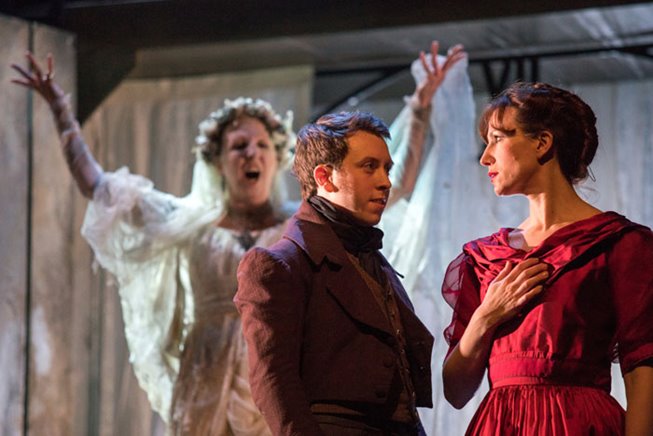
It is intensely frustrating when there are clear virtues in a play but it is ultimately unwound by too many hiccups and overarching structural issues. Such is the case with Great Expectations. On the positive side, I have much praise to heap on the cast – particularly in the supporting roles. James Dinsmore, Eliza Collings and Edward Ferrow stand out, hopping between a variety of characters and giving each of them a well differentiated presence. Nichola McAuliffe gets the chunky role of Miss Havisham and is indeed impressive but the play has been too greatly framed around the character. Yes, she is iconic but she is ultimately a supporting role (and a bit of a red herring) in the overall narrative. As such the limited scope of the character becomes apparent with overexposure. Less would perhaps have been more.
That is sadly the least of the questionable choices. Séan Aydon manages Pip well as an adult but gets off to a rough start in the childhood sections. He has been directed to use a piercing yelp to indicate Pip’s unbroken voice. This is irritating and compounds another problem: his rendition of a rural accent lacks diction so, in these early scenes, syllables and lines are lost.
Then we come to the lacklustre staging. Part of the stage is taken up by a multi-purpose cube/cage structure. There is no reason this should not work – in fact, I tend to prefer creative uses of very minimal sets that suggest their environments – but there is little rhyme or reason with how this space is interacted with. It’s often an interior space, but then so are are some scenes outside of it. The negative space composing the rest of the stage is not used to good effect: the actors simply stand at front stage left. In general there is a want of dynamic blocking. Everything is very flat and static.
Many of the other problems would have been perhaps caveats in a stronger piece, but I think this production of Great Expectations flounders due to a fundamentally misjudged adaptation by Ken Bentley. Scenes are occasionally bookended by narration which is often redundant given the information communicated in the scene. It fails to let the performance speak for itself.
The selection of scenes from the novel shows a clear weighting towards iconic scenes and revelations (as with Miss Havisham, above) but that means the buildup is hamstrung and the flow of the story lumpy. Case and point, the second half has three lengthy exposition scenes almost back-to-back. A more judicious adaptor would have broken this up a bit and parsed out clues (which are present in the novel) so these scenes could be punchier because they are built on earlier foundations. This deference to the text does not recognise that a play has fundamentally different needs than a novel. The worst example though is the development of the relationship between Pip and Estella. It gets little consistent attention but each half culminates with great bombast about the central importance of this aspect. This is not borne out at all by the rest of the play.
It’s a great pity. I just wish the talent off-stage had been working as hard as the people on it. ★★☆☆☆ Fenton Coulthust 9th May 2018

